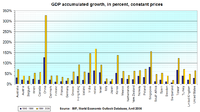
Photo from wikipedia
We study the relation between income distribution and growth, mediated by structural changes on the demand and supply sides. Using the results from a multi-sector growth model, we compare two… Click to show full abstract
We study the relation between income distribution and growth, mediated by structural changes on the demand and supply sides. Using the results from a multi-sector growth model, we compare two growth regimes that differ in three aspects: labour relations, competition and consumption patterns. Regime one, similar to Fordism, is assumed to be relatively less unequal, more competitive and to have more homogeneous consumers than regime two, which is similar to post-Fordism. We analyse the parameters that define the two regimes to study the role of the economy’s exogenous institutional features and endogenous structural features on output growth, income distribution, and their relation. We find that regime one exhibits significantly lower inequality, higher output and productivity and lower unemployment compared to regime two, and that both institutional and structural features explain these differences. Most prominent amongst the first group are wage differences, accompanied by capital income and the distribution of bonuses to top managers. The concentration of production magnifies the effect of wage differences on income distribution and output growth, suggesting the relevance of competition norms. Amongst structural determinants, firm organisation and the structure of demand are particularly relevant. The way that final demand is distributed across sectors influences competition and overall market concentration; demand from the least wealthy classes is especially important. We show also the tight linking between institutional and structural determinants. Based on this linking, we conclude by discussing a number of policy implications that emerge from our model.
Journal Title: Journal of Evolutionary Economics
Year Published: 2019
Link to full text (if available)
Share on Social Media: Sign Up to like & get
recommendations!